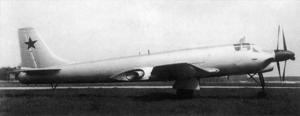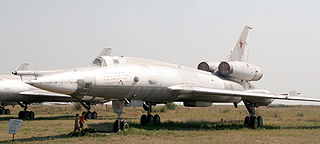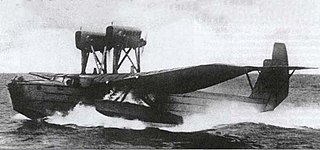
The Tupolev Tu-114 Rossiya is a retired large turboprop-powered long-range airliner designed by the Tupolev design bureau and built in the Soviet Union from May 1955. The aircraft was the largest and fastest passenger plane at that time and also had the longest range, at 10,900 km (6,800 mi). It has held the official title of fastest propeller-driven aircraft since 1960.

The Tupolev Tu-124 is a 56-passenger short-range twinjet airliner built in the Soviet Union. It was the first Soviet airliner powered by turbofan engines.

The Tupolev Tu-110 was a jet airliner designed and built in the USSR, which saw its maiden flight in 1957.

The Tupolev Tu-80 was a Soviet prototype for a longer-ranged version of the Tupolev Tu-4 bomber, an unlicensed, reverse engineered copy of the Boeing B-29 Superfortress. It was cancelled in 1949 in favor of the Tupolev Tu-85 program which offered even more range. The sole prototype was used in various test programs before finally being used as a target.
The Tupolev Tu-75 was a military transport variant of the Tu-4 bomber, an unlicensed, reverse engineered copy of the Boeing B-29 Superfortress. The Tu-75 was similar to the Tu-70 airliner, both using a new, purpose-designed fuselage. The first Soviet military machine of this class, it was equipped with a rear fuselage loading ramp. It was not placed into production because the VVS decided it would be cheaper to modify its existing Tu-4s for the transport mission and to use its existing Lisunov Li-2 and Ilyushin Il-12 transports.

The Tupolev Tu-91 was a two-seat Soviet attack aircraft built during the 1950s. It was initially designed as a carrier-borne aircraft, but was converted into a land-based aircraft after Joseph Stalin's death in 1953 cancelled the aircraft carriers being designed. Two prototypes had been built and production had been approved by the Soviet Navy when it was inspected by the General Secretary, Nikita Khrushchev, in 1956. He remarked how ridiculous the Tu-91 looked and the program was cancelled.

The Tupolev Tu-22 was the first supersonic bomber to enter production in the Soviet Union. Manufactured by Tupolev, the Tu-22 entered service with Long-Range Aviation and Soviet Naval Aviation in the 1960s.

The Tupolev Tu-95 is a large, four-engine turboprop-powered strategic bomber and missile platform. First flown in 1952, the Tu-95 entered service with the Long-Range Aviation of the Soviet Air Forces in 1956 and was first used in combat in 2015. It is expected to serve the Russian Aerospace Forces until at least 2040.

The Tupolev Tu-14, was a Soviet twinjet light bomber derived from the Tupolev '73', the failed competitor to the Ilyushin Il-28 'Beagle'. It was used as a torpedo bomber by the mine-torpedo regiments of Soviet Naval Aviation between 1952–1959 and exported to the People's Republic of China.

The Tupolev TB-1 was a Soviet bomber aircraft, an angular monoplane that served as the backbone of the Soviet bomber force for many years, and was the first large all-metal aircraft built in the Soviet Union.

The Tupolev TB-3, OKB designation ANT-6, was a monoplane heavy bomber deployed by the Soviet Air Force in the 1930s and used during the early years of World War II. It was one of the world's first cantilever wing four-engine heavy bomber. Despite obsolescence and being officially withdrawn from service in 1939, the TB-3 performed bomber and transport duties throughout much of World War II. The TB-3 also saw combat as a Zveno project fighter mothership and as a light tank transport.

The Beriev Be-6 was a flying boat produced by the Soviet Beriev OKB. It was capable of accomplishing a wide variety of missions, such as long-range maritime reconnaissance, coastal and supply line patrols, torpedo/bombing strikes, mine-laying, and transport operations.

The Tupolev ANT-14 Pravda was a Soviet aircraft, which served as the flagship of the Soviet propaganda squadron. It has been credited as Russia's first all-metal aircraft, with a corrosion-resistant-steel structure.
The Tupolev ANT-9 was a Soviet passenger aircraft of the 1930s. It was developed as a reaction to the demand for a domestic airliner. At this time Deruluft, one of the forerunners of Aeroflot, flew only with foreign models, which were mainly German or Dutch.

The ANT-8 was an experimental flying boat designed by Tupolev. It was designated the "MDR-2" by the military.

The Tupolev ANT-22 was a large flying boat built in the Soviet Union in 1934. A huge aircraft consisting of two hulls and powered by six engines in three nacelles in a push-pull configuration, it was based on the ANT-11, which was never built. Its enormous weight severely crippled its performance, and it never proceeded beyond the experimental stage.

The Tupolev I-14 was a Soviet fighter aircraft of the 1930s. It was a single-engined, single-seat monoplane with retractable undercarriage, designed to carry heavy armament, and as such was one of the most advanced fighters of its time. It was ordered into production, but this was cancelled after only a small number had been built, the competing Polikarpov I-16 being preferred.
The Tupolev ANT-10 was a prototype single-engined light bomber/reconnaissance aircraft of the 1930s. Only a single example was built, the Polikarpov R-5 being preferred.
The Tupolev ANT-21 was a Soviet twin-engined four-seat heavy fighter, which also had the designation MI-3. It was not accepted for production, only two prototypes being built.
The Tupolev ANT-41 was a prototype Soviet twin-engined torpedo-bomber of the 1930s. A single prototype was built, which was destroyed in a crash. No production followed, with the Ilyushin DB-3 serving as a torpedo bomber instead.

















